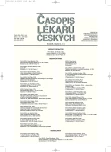Alternative methods of microvolt T wave alternans measurements in patients with left ventricular cardiac dysfunction
Authors:
Lubomír Křivan; Petr Lokaj; Milan Kozák; Milan Sepši; Pavel Trčka; Jitka Vlašínová; Lucie Burešová; Jindřich Špinar
Authors‘ workplace:
Fakultní nemocnice Brno, Interní kardiologická klinika
Published in:
Čas. Lék. čes. 2010; 149: 423-428
Category:
Original Article
Overview
Background.
The presence of a microvolt T wave alternans (MTWA) is linked with increased risk of malignant arrhythmias and overall mortality. The most common method used for MTWA detection is a bicycle exercise test (BET). Method has still several limitations.
Aim.
To confirm that comparable MTWA results may be obtained by atrial and ventricular pacing during electrophysiology. To identify an anticipated relation between MTWA and malignant arrhythmia occurrence, or a death.
Methods.
We obtained MTWA during BET and consequently during atrial and ventricular pacing. All patients underwent a routine electrophysiology testing prior to prophylactic ICD implantation. The results were compared. The occurrence of malignant arrhythmias and death were registered during follow-up.
Results.
The group consisted of 39 patients. The results of MTWA obtained by BET, atrial and ventricular pacing did not show a significant difference. No difference was found among the three methods in the number of positive leads, and onset heart rate. Ventricular pacing increases the magnitude of MTWA comparing to the remaining two methods. No relation between MTWA results and occurrence of malignant arrhythmias or death was found.
Conclusions.
Atrial and ventricular pacing lead to comparable MTWA results as BET and may be used as alternative methods in patients where BET is not feasible.
Key words:
microvolt T wave alternans, bicycle exercise test, atrial pacing, ventricular pacing, malignant arrhythmias.
Sources
1. Myerburg RJ, Castellanos A. Cardiac arrest and suddeen cardiac death. In: Braunwald E, ed. Heart Disease: A Textbook of cardiovascular medicine. New York: WB Saunders1997; 742–749.
2. Myerburg RJ, Kessler KM, Castellanos A. Sudden cardiac death. Structure, function and time-dependence od risk. Circulation 1992; 85: 2–10.
3. Ding L, Hua W, Niu H, et al. Primary prevention of sudden cardiac death using implantable cardioverter defibrillators. Europace 2008; 10: 1034–1041.
4. Křivan L. Primární prevence náhlé srdeční smrti – ICD pro všechny pacienty s dysfunkcí srdeční komory? Cor Vasa 2010; 52(1–2): 30–35.
5. Zipes PD, Camm AJ, Borggrefe M, et al. ACC/AHA/ESC 2006 Guidelines for management of patients with ventricular arrhythmias and the prevention of sudden cardiac death. JACC 2006; 48(5): e247–e346.
6. Gehi AK, Stein HR, Metz LD. Mikrovolt T-wave alternans for the risk stratification of ventricular tachyarrhythmic events. A meta-analysis. JACC 2005; (46)1: 75–82.
7. Bloomfield DM, Bigger JT, Steinman R. et al. Microvolt T‑wave alternans and the risk of death or sustained ventricular arrhythmias in patients with left ventricular dysfunction. JACC 2006; (47)2: 456–463.
8. Narayan SM. T-wave alternans and the susceptibility to ventricular arrhythmias. JACC 2006; (47)2: 269–281.
9. Tang WH, Francis GS. The year in heart failure. JACC 2007; 50: 2344–2351.
10. Madias JE. T-Wave alternans and intraventricular coduction delays. JACC 2008; 51(9): 969–970.
11. Klingenheben T, Ptaszynski P, Hohnloser SH. Quantitative assessment of mikrovolt T-wave alternans in patiens with congestive heart failure. J Cardiovasc Electrophysiol 2005; 16: 620–624.
12. Tanno K, Ryu S, Watanabe N, et al. Microvolt T-wave alternans as a predictor of ventricular tachyarrhythmias. A prospective study using atrial pacing. Circulation 2004; 109: 1854–1858.
13. Shalaby AA, Voigt A, El-Saed A, et al. Microvolt T-Wave alternans during atrial and ventricular pacing. PACE 2007; 30: S178–S182.
14. Raatikainen MJ, Jokinen V, Virtanen V, et al. Microvolt T‑wave alternans during exercise and pacing in patients with acute myocardial infarction (CARISMA trial substudy). PACE 2005; 28: S193–S197.
15. Bloomfield DM, Steinman RC, Namerow PB, et al. Microvolt T-wave alternans ditinguishes between patients likely and patients not likely to benefit from implanted cardiac defibrillator therapy. A solution to the multicenter automatic defibrillator implantation trial (MADIT) II conundrum. Circulation 2004; 110: 1885–1889.
16. Chow T, Kereiakes DJ, Onufer J, et al. Does microvolt T‑wave alternans testing predict ventricular tachyarrhythmias in patients with ischemic cardiomyopathy and prophylactic defibrillators? The MASTER (Microvolt T wave alternans aesting for risk atratification of post myocardial infarction patients) Trial. JACC 2008; 52: 1607–1615.
17. Chow T, Joshi D. Microvolt T-wave alternans testing for ventricular arrhythmia risk stratification. Expert Rev Cardiovasc Ther 2008; 6(6): 833–842.
Labels
Addictology Allergology and clinical immunology Angiology Audiology Clinical biochemistry Dermatology & STDs Paediatric gastroenterology Paediatric surgery Paediatric cardiology Paediatric neurology Paediatric ENT Paediatric psychiatry Paediatric rheumatology Diabetology Pharmacy Vascular surgery Pain management Dental HygienistArticle was published in
Journal of Czech Physicians

- Metamizole vs. Tramadol in Postoperative Analgesia
- Metamizole at a Glance and in Practice – Effective Non-Opioid Analgesic for All Ages
- Advances in the Treatment of Myasthenia Gravis on the Horizon
- Current Insights into the Antispasmodic and Analgesic Effects of Metamizole on the Gastrointestinal Tract
- Spasmolytic Effect of Metamizole
Most read in this issue
- A new simple method for estimating trunk and visceral fat by bioelectrical impedance: Comparison with magnetic resonance imaging and dual X-ray absorptiometry in Czech adolescents
- Clinical, biochemical and molecular characteristics in 11 Czech children with tyrosinemia type I
- Shopping as problem: shopping addiction
- Alternative methods of microvolt T wave alternans measurements in patients with left ventricular cardiac dysfunction
